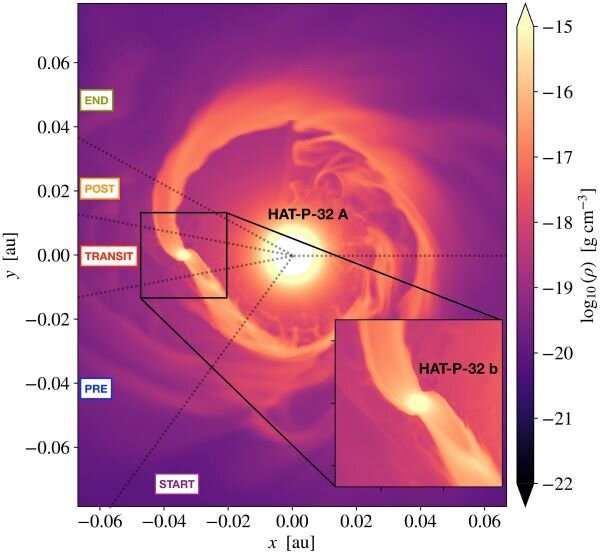This article has been reviewed according to Science X's editorial process and policies. Editors have highlighted the following attributes while ensuring the content's credibility:
fact-checked
peer-reviewed publication
trusted source
proofread
Astronomers observe giant tails of helium escaping Jupiter-like planet

A team of astronomers has used observations from the Hobby-Eberly Telescope (HET) at The University of Texas at Austin's McDonald Observatory to discover some of the longest tails of gas yet observed escaping a planet.
The planet, HAT-P-32b, is nearly twice the size of Jupiter and losing its atmosphere through dramatic jets of helium unfurling before and behind it as it travels through space. These tails are more than 50 times the length of the planet's radius. The discovery is published June 7 in the journal Science Advances.
Tails of escaping material around planets are not unheard of. They can be the result of a collision freeing a trail of dust and debris. Or, they can be caused by the heat of a nearby star energizing and blowing a planet's atmosphere into space. However, tails as long as HAT-P-32b's are truly remarkable.
"It is exciting to see how gigantic the extended tails are compared to the size of the planet and its host star," said Zhoujian Zhang, NASA Sagan fellow at the University of California, Santa Cruz. He led the team that made this discovery while part of The University of Texas at Austin HET Exospheres Project. The HET Exospheres Project studies the atmospheres of planets outside of our solar system.
Detecting HAT-P-32b's dramatic tails
To learn about the atmosphere of planets outside our solar system, astronomers can observe their parent star while the planet passes in front of it. This is what is referred to as a "transit." One example would be when Venus passes between the Earth and sun.
During a transit, the star shines light through the passing planet's atmosphere—if there is one. Through a method called "spectroscopy," astronomers can study this light to identify what elements are present in the atmosphere. With spectroscopy, the light is broken into a spectrum, much like white light shining through a prism. Different bands of color in the spectrum correspond to different elements.
Previous studies had detected HAT-P-32b's tails. However, because astronomers had only observed the planet while it was passing in front of its star, the tails' true sizes remained unknown.
"We would not have seen this without the long-timeframe observations that we can get with the Hobby-Eberly Telescope," said Caroline Morley, assistant professor at The University of Texas at Austin and principal investigator for the HET Exospheres Project. "It allowed us to observe this planet for its full orbit."
Zhang's team observed HAT-P-32b over the course of several nights, capturing the moment when the planet crossed in front of the star as well as observations in the days before and after. This covered the full time it takes for the planet to orbit its star, ensuring the full extent of its tails was revealed.
HAT-P-32b's tails are likely caused by its parent star boiling off the planet's atmosphere. The planet is what astronomers refer to as a "hot Jupiter," meaning it is big, hot, gassy and has a close orbit around its star. Its orbit is so tight that the heat from its parent star is causing the gas in HAT-P-32b's atmosphere to expand. The atmosphere has expanded so much that some of it has escaped the planet's gravitational pull and been drawn into orbit around the nearby star.
"Our findings on HAT-P-32b may help us understand how other planets and their stars interact," said Morley. "We are able to take high-precision measurements on hot Jupiters, like this one, and then apply our findings to a wider range of planets."
Hobby-Eberly Telescope (HET) and the study of planetary atmospheres
The HET is particularly well suited to studying atmospheres on planets outside our solar system. Its high-resolution instrument, the Habitable-Zone Planet Finder spectrograph, is able to observe objects at near-infrared wavelengths. This includes the wavelength associated with helium, allowing astronomers to observe the gas escaping HAT-P-32b and other similar planets.
Another advantage of observing with HET is that it surveys the same sweep of sky each night. Unlike most other telescopes, which tilt up and down, the HET's 10- by 11-meter mirror is always tilted at 55 degrees above the horizon. This can lead to high-precision, long-timeline observations of the same swath of sky each night.
"Because we can observe the system every night for several days in a row, we can detect physically large structures like this one," said Zhang. "Other planets might also have extended escaping atmospheres waiting to be discovered through similar monitoring."
More information: Zhoujian Zhang et al, Giant tidal tails of helium escaping the hot Jupiter HAT-P-32 b, Science Advances (2023). DOI: 10.1126/sciadv.adf8736
Journal information: Science Advances
Provided by University of Texas McDonald Observatory




















